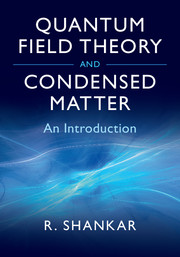Book contents
- Frontmatter
- Dedication
- Contents
- Preface
- 1 Thermodynamics and Statistical Mechanics Review
- 2 The Ising Model in d = 0 and d = 1
- 3 Statistical to Quantum Mechanics
- 4 Quantum to Statistical Mechanics
- 5 The Feynman Path Integral
- 6 Coherent State Path Integrals for Spins, Bosons, and Fermions
- 7 The Two-Dimensional Ising Model
- 8 Exact Solution of the Two–Dimensional Ising Model
- 9 Majorana Fermions
- 10 Gauge Theories
- 11 The Renormalization Group
- 12 Critical Phenomena: The Puzzle and Resolution
- 13 Renormalization Group for the ϕ4 Model
- 14 Two Views of Renormalization
- 15 Renormalization Group for Non-Relativistic Fermions: I
- 16 Renormalization Group for Non-Relativistic Fermions: II
- 17 Bosonization I: The Fermion–Boson Dictionary
- 18 Bosonization II: Selected Applications
- 19 Duality and Triality
- 20 Techniques for the Quantum Hall Effect
- Index
- References
17 - Bosonization I: The Fermion–Boson Dictionary
Published online by Cambridge University Press: 24 October 2017
- Frontmatter
- Dedication
- Contents
- Preface
- 1 Thermodynamics and Statistical Mechanics Review
- 2 The Ising Model in d = 0 and d = 1
- 3 Statistical to Quantum Mechanics
- 4 Quantum to Statistical Mechanics
- 5 The Feynman Path Integral
- 6 Coherent State Path Integrals for Spins, Bosons, and Fermions
- 7 The Two-Dimensional Ising Model
- 8 Exact Solution of the Two–Dimensional Ising Model
- 9 Majorana Fermions
- 10 Gauge Theories
- 11 The Renormalization Group
- 12 Critical Phenomena: The Puzzle and Resolution
- 13 Renormalization Group for the ϕ4 Model
- 14 Two Views of Renormalization
- 15 Renormalization Group for Non-Relativistic Fermions: I
- 16 Renormalization Group for Non-Relativistic Fermions: II
- 17 Bosonization I: The Fermion–Boson Dictionary
- 18 Bosonization II: Selected Applications
- 19 Duality and Triality
- 20 Techniques for the Quantum Hall Effect
- Index
- References
Summary
“Bosonization” refers to the possibility of describing a theory of relativistic Dirac fermions obeying standard anticommutation rules by a boson field theory. While this may be possible in all dimensions, it has so far proved most useful in d = 1, where the bosonic version of the given fermionic theory is local and simple, and often simpler than the Fermi theory. This chapter should be viewed as a stepping stone toward a more thorough approach, for which references are given at the end.
In this chapter I will set up the bosonization machine, explaining its basic logic and the dictionary for transcribing a fermionic theory to a bosonic theory. The next chapter will be devoted to applications.
To my knowledge, bosonization, as described here, was first carried out by Lieb and Mattis [1] in their exact solution of the Luttinger model [2]. Later, Luther and Peschel [3] showed how to use it to find asymptotic (low momentum and energy) correlation functions for more generic interacting Fermi systems. It was independently discovered in particle physics by Coleman [4], and further developed by Mandelstam [5]. Much of what I know and use is inspired by the work of Luther and Peschel.
Preamble
Before getting into any details, I would first like to answer two questions. First, if bosonization applies only to relativistic Dirac fermions, why is it of any interest to condensed matter theory where relativity is not essential? Second, what is the magic by which bosonization helps us tame interacting field theories?
As for the first question, there are two ways in which Dirac fermions enter condensed matter physics. The first is in the study of two-dimensional Ising models, where we have already encountered them. Recall that if we use the transfer matrix approach and convert the classical problem on an N ×N lattice to a quantum problem in one dimension we end up with a 2N-dimensional Hilbert space, with a Pauli matrix at each of N sites. The two dimensions at each site represent the twofold choice of values open to the Ising spins. Consider now a spinless fermion degree of freedom at each site. Here too we have two choices: the fermion state is occupied or empty.
- Type
- Chapter
- Information
- Quantum Field Theory and Condensed MatterAn Introduction, pp. 319 - 333Publisher: Cambridge University PressPrint publication year: 2017
- 1
- Cited by



